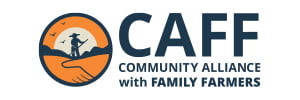DISASTER RECOVERY
In the aftermath of a disaster, it might seem like there’s no hope. But in fact, a number of resources exist for survivors as well as affected farms and communities. From financial aid to techniques that help restore your land after a fire, we’ve compiled these resources to help get you back on your feet.


FINANCIAL AID
Whether you lost your home, property, crops, livestock forage or a job, there are many options that might help you recoup your losses.


Webinar: Small Farms Disaster Insurance Part 1
From Farmer Campus, this webinar provides an overview of insurance for small farms, including how insurance works and what to buy.

Financial Recovery And Support After A Wildfire
In this two part photo blog series, Farmer Campus talked with farm manager David Cooper to hear his wildfire story and get a glimpse into the realities of farming with wildfire and how to recover.

Counting the Losses: Tallying the True Costs of Wildfire for Farmers
In this two part photo blog series, Farmer Campus talked with farm manager David Cooper to hear his wildfire story and get a glimpse into the realities of farming with wildfire and how to recover.

Fire Recovery Assistance from the U.S. Department of Agriculture
The U.S. Department of Agriculture has multiple agencies that provide financial and/or technical assistance to help farmers, ranchers and rural landowners recover from natural disasters, such as wildfires. Listed are USDA agencies and an overview of applicable programs. Funding for

USDA Disaster Assistance Programs At a Glance
A quick summary of all of FSA (Farm Service Agency) disaster programs and a guide that shows what type of disasters they cover.

Disaster Assistance Discovery Tool
Learn about USDA disaster assistance programs that might be right for you by completing five simple steps.

Insurance Post-Declared Disaster
If you are a property owner and your property is located in an area designated as a disaster by the President of the United States or the Governor, and you cannot locate the insurance policy for the property and are

Small Business Disaster Loan Assistance
SBA provides low-interest disaster loans to businesses of all sizes, private non-profit organizations, homeowners, and renters. SBA disaster loans can be used to repair or replace the following items damaged or destroyed in a declared disaster: real estate, personal property,

LAND MANAGEMENT POST-DISASTER
Disasters can wreak havoc on your land. How you manage your land in the weeks and months following a disaster will determine well those natural resources recover.


Guía Sobre Incendios Forestales y Inocuidad Alimentaria
INTRODUCCIÓN La Ley de Modernización de Inocuidad de los Alimentos fue promulgada en 2011 y comprende numerosas normas. Una de ellas es la Norma de Seguridad de los Productos Agrícolas Frescos (PSR, por sus siglas en inglés), que fue creada

What to Know About Wildfire and Food Safety
Introduction In 2011 the Food Safety Modernization Act was signed into law. Of the many rules in this law, the Produce Safety Rule (PSR) was created to address federal food safety requirements at the farm level, specifically for produce crops.
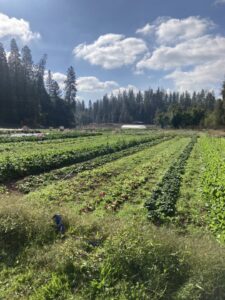
Gully Stuffing
Gullies pose many threats to farmland, including the removal of fertile topsoil, damage to infrastructure, danger to livestock, and decreased water quality. Also, due to loss of protective vegetation, erosion can increase after wildfire. Gully stuffing can reduce water velocity,

2019 Camp Fire Water Resources Monitoring and Research Symposium
The symposium brought together researchers who have been investigating the impacts of the Camp Fire and other urban fires in Northern California. Speakers covered a diversity of research conducted on waterways, gardens, working landscapes and the urban environment following the

Wildfire and Food Safety References
CAFF’s Wildfire Resilience Program collaborated with the National Farmers Union to create a unique resource called “What to Know About Wildfire & Food Safety”. Be sure to peruse the links below and learn more about how wildfires can impact soil

Webinar: Post-Fire Remediation and Watershed Defense
From CoRenewal, this webinar features Taylor Bright and Matthew Trumm, who will explain the how, what and why of proposed bioremediation approaches, and lessons learned during post-fire wattle biofiltration installations after the 2018 Camp Fire.

Episode 2: Wild Oat Hollow Penngrove, CA
In this episode, Sarah Keiser of Wild Oat Hollow in Penngrove, CA describes her entry into ranching and how her love of the land positioned her to become a leader in developing and supporting community grazing cooperatives. Join us as
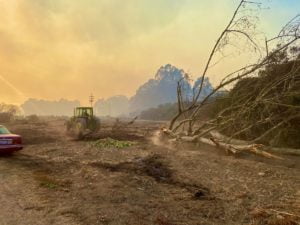
New Podcast Season: Farmer Stories of Wildfire Recovery & Preparedness
CAFF’s Wildfire Resilience Program provides specialized recovery and preparedness resources for small farms and communities in California impacted by wildfire and those seeking to prepare against future threats. One of the best mediums for conducting this type of outreach and

LIVESTOCK AFTER A DISASTER
Disasters can greatly affect the health of your animals. Help ensure a sound recovery for everyone living on your farm or ranch.


Guía Sobre Incendios Forestales y Inocuidad Alimentaria
INTRODUCCIÓN La Ley de Modernización de Inocuidad de los Alimentos fue promulgada en 2011 y comprende numerosas normas. Una de ellas es la Norma de Seguridad de los Productos Agrícolas Frescos (PSR, por sus siglas en inglés), que fue creada

2019 Camp Fire Water Resources Monitoring and Research Symposium
The symposium brought together researchers who have been investigating the impacts of the Camp Fire and other urban fires in Northern California. Speakers covered a diversity of research conducted on waterways, gardens, working landscapes and the urban environment following the

Wildfire Ash: Impacts on Forage Crops
A report from the University of California Agriculture and Natural Resources with findings from a study on the impacts of wildfire ash deposition on crops grazed or harvested for livestock feed.

Episode 2: Wild Oat Hollow Penngrove, CA
In this episode, Sarah Keiser of Wild Oat Hollow in Penngrove, CA describes her entry into ranching and how her love of the land positioned her to become a leader in developing and supporting community grazing cooperatives. Join us as

New Podcast Season: Farmer Stories of Wildfire Recovery & Preparedness
CAFF’s Wildfire Resilience Program provides specialized recovery and preparedness resources for small farms and communities in California impacted by wildfire and those seeking to prepare against future threats. One of the best mediums for conducting this type of outreach and
Episode 1: Turkey Tail Farm – Yankee Hill
In this episode we visit Cheetah Tchudi at his diversified operation in Yankee Hill, Butte County, CA. Cheetah shares his experience surviving the 2018 Paradise wildfire, and some methods for recovery; addressing toxic ash using fungi to capture and and

How to Establish an Ag/Livestock Pass Program from UC ANR
A detailed description of how to establish a county-based program that grants agriculturalists special access to their farms or ranches during disaster.
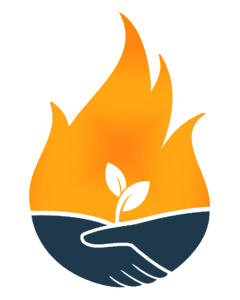
5 Key Wildfire Resilience Practices
It’s not always obvious that some of the ecological farming practices used frequently by farmers, also provide wildfire protection and recovery benefits. Check out the infographic below which was developed by our cross team at CAFF to learn more! Click

Produce Safety & Food Recovery
Is your produce safe to eat after a disaster? And how can farmers assist in feeding those in feed? And how do you keep your business going in the aftermath?


Guía Sobre Incendios Forestales y Inocuidad Alimentaria
INTRODUCCIÓN La Ley de Modernización de Inocuidad de los Alimentos fue promulgada en 2011 y comprende numerosas normas. Una de ellas es la Norma de Seguridad de los Productos Agrícolas Frescos (PSR, por sus siglas en inglés), que fue creada

What to Know About Wildfire and Food Safety
Introduction In 2011 the Food Safety Modernization Act was signed into law. Of the many rules in this law, the Produce Safety Rule (PSR) was created to address federal food safety requirements at the farm level, specifically for produce crops.

2019 Camp Fire Water Resources Monitoring and Research Symposium
The symposium brought together researchers who have been investigating the impacts of the Camp Fire and other urban fires in Northern California. Speakers covered a diversity of research conducted on waterways, gardens, working landscapes and the urban environment following the

Food Safety in Disaster or Emergency
Another resource with information about keeping food safe before, during, and after emergencies, such as floods, fires, natural disasters, or the loss of power.

Wildfire Retardant Impacts to Organic Certification
In this episode of ‘Sustainability Now!’ host Ronnie Lipschutz and guests Amber Schat and David Obermiller discuss farmers facing the loss of organic certification due to climate-related disasters and wildfires.
Episode 1: Turkey Tail Farm – Yankee Hill
In this episode we visit Cheetah Tchudi at his diversified operation in Yankee Hill, Butte County, CA. Cheetah shares his experience surviving the 2018 Paradise wildfire, and some methods for recovery; addressing toxic ash using fungi to capture and and
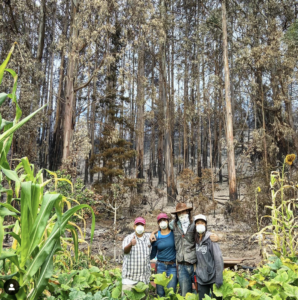
Food Safety & Wildfires Case Study: Brisa Ranch
Key Details: Location: San Francisco bay area , near Pescadero Acres in Production: 16 Main Crops: Fruit, vegetables, flowers Wildfire: CZU Complex in 2020 3rd Party Audit(s): USDA Harmonized GAP Certified Organic by National Organic Program: Yes Owners: Cristóbal, Cole,

COMMUNITY RESPONSE & RECOVERY
Tips and resources to help your community work together to ensure an effective, equitable recovery.


New Podcast Season: Farmer Stories of Wildfire Recovery & Preparedness
CAFF’s Wildfire Resilience Program provides specialized recovery and preparedness resources for small farms and communities in California impacted by wildfire and those seeking to prepare against future threats. One of the best mediums for conducting this type of outreach and
Episode 1: Turkey Tail Farm – Yankee Hill
In this episode we visit Cheetah Tchudi at his diversified operation in Yankee Hill, Butte County, CA. Cheetah shares his experience surviving the 2018 Paradise wildfire, and some methods for recovery; addressing toxic ash using fungi to capture and and

Service Providers for Small Farmers – Crowd Sourced
From Farmer Campus, this crowd sourced spreadsheet contains recommendations for farmers to obtain support and connect with agents around disaster and crop insurance, as well as bookkeepers, CPAs, and attorneys.

Protecting Outdoor Workers Exposed to Smoke from Wildfires
Smoke from wildfires contains chemicals, gases and fine particles that can harm health, especially those working outdoors. We know our family famers want to keep their crews safe and healthy. Learn more here and please take all necessary precautions for

Coping with Disaster
This page offers disaster survivors information regarding dealing with the emotional effects of the event. Below you will find guidance on recognizing the signs of and minimizing the impact of disaster-caused stress. Please remember that reactions and risk response to disasters

Helping Children Cope with Disaster
This booklet offers parents, caregivers, and other adults suggestions on how to help children cope with the effects of disaster, as well as how to be prepared before a disaster strikes.

Office of Recovery and Resiliency
Sonoma County was har hit by recent fires however they have become a model for resilience and innovation. The Sonoma County Board of Supervisors have approved the “Recovery and Resiliency Framework” to serve as a vision and approach for how

Fire Adapted Communities Learning Network
The Network connects and supports people and communities who are striving to live more safely with wildfire, a catalyst for spreading best practices and innovations in fire adaptation concepts nationwide. The purpose of FAC Net is to exchange information, collaborate

Before Disaster Strikes
Is your farm ready for a natural disaster? We know it’s not easy to find time for all of today’s chores, let alone time to prepare for all the events that might or might not happen. But a little preparation now could save you countless hours, heartache, money and even your life and the lives of those you love. Check out these resources to help prepare your home, land, family, animals and community for the very real possibility of disaster.



And to the hundreds of California farms, individuals and businesses that donated to The Just & Resilient Future Fund



